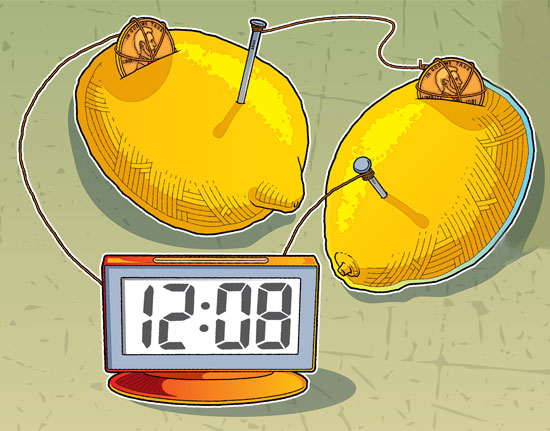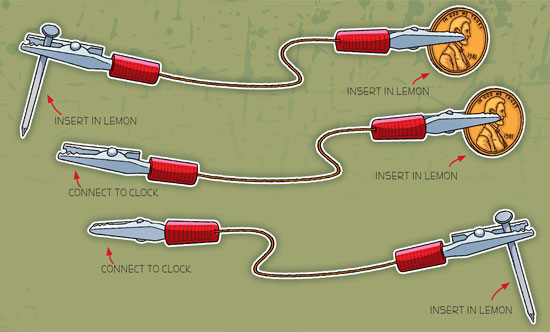How to Build a Lemon-Powered Clock
Power a digital clock by making a battery out of lemons.

WHAT YOU’LL NEED
- 2 ripe lemons
- Low-voltage digital clock (Use a clock that takes one AA battery or a 1.5-volt button cell battery. One AA battery has about 1.5 volts of energy. Two lemons should produce about 1.5 volts.)
- 2 copper pennies (If your penny has a date before 1982, it is made of 95 percent copper. If the date is 1982 or later, it is made of 97.5 percent zinc with a thin copper coating. The old pennies work better.)
- 3 8″ lengths of copper wire
- 2 galvanized nails (Galvanized nails are coated with zinc.)
- Knife
- Scissors
- Clip leads (alligator clips), optional
WHAT YOU’LL DO
 1. Roll the lemons on a hard surface, being careful not to break the skin. (This will loosen the pulp, make the lemons juicy and help the electrons move through the lemons.)
1. Roll the lemons on a hard surface, being careful not to break the skin. (This will loosen the pulp, make the lemons juicy and help the electrons move through the lemons.)
 2. Wrap one end of a wire around a penny and the other around the end of a nail. (These will be used to connect the lemons together. Connecting lemons with metal wires adds voltage from each lemon. The more lemons you connect together, the higher the voltage.)
2. Wrap one end of a wire around a penny and the other around the end of a nail. (These will be used to connect the lemons together. Connecting lemons with metal wires adds voltage from each lemon. The more lemons you connect together, the higher the voltage.)
 3. Connect a second wire to a penny and leave the other end bare.
3. Connect a second wire to a penny and leave the other end bare.
 4. Wrap the third wire around a nail and leave the other end bare.
4. Wrap the third wire around a nail and leave the other end bare.
 5. Cut a slit in each lemon just large enough to insert the pennies. Insert the pennies and nails as shown in the image at the top of this page. (Make sure the copper wire has good contact with both the pennies and nails, and make sure the pennies and the nails make good contact with the lemon pulp and juice.)
5. Cut a slit in each lemon just large enough to insert the pennies. Insert the pennies and nails as shown in the image at the top of this page. (Make sure the copper wire has good contact with both the pennies and nails, and make sure the pennies and the nails make good contact with the lemon pulp and juice.)
 6. Remove the battery from the clock and touch the wires to the positive and negative terminals in the clock. If your clock doesn’t work, try switching the wires.
6. Remove the battery from the clock and touch the wires to the positive and negative terminals in the clock. If your clock doesn’t work, try switching the wires.
7. You can also use clip leads (alligator clips) to connect your wires to the pennies, nails and clock, as shown below.

PHOTOS OF COMPLETED PROJECT
Check out these photos of completed lemon-powered clocks sent to us by Boys’ Life readers. If you have a photos of a BL Workshop project, please use the form below to send them to us.

it really works
i am gonna try this
Looks awesome! I’d do that!
Does this have to do with the acid in the lemon?
Yes
I think this is a way better way to power my clock.
im really gonna try this
im using this for my science far project but i modified
this is very cool mamby it could get me a good grade in the science fair
Will you please describe the mechanism behind it? I don’t understand the reason behind copper and zinc plate. Is there any idea behind it? And in step 2, why the two lemons were joined by a single copper wire?
If you dont complete the circuit, then it wont work! Meaning, if lemon 1 is connected to nail 1, positive end, and penny one, and lemon 2 is connected to nail 2, penny 2, and negative end, but the two lemons have no OBVIOUS connection, then the circuit is incomplete, like putting bread in the toaster and turning it on, but you didn’t plug it in or put in batteries, then it wont work.
Amazing! Really works and also made one out of orange!
cool